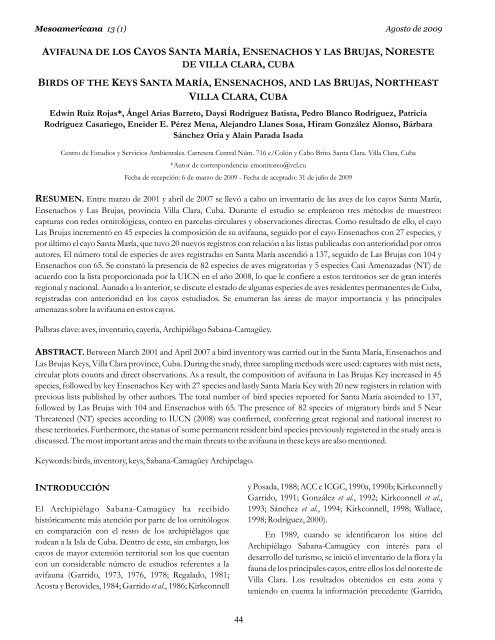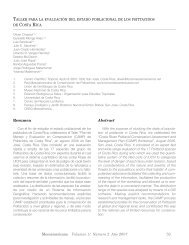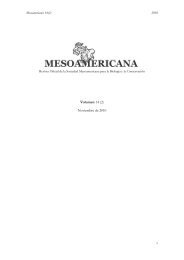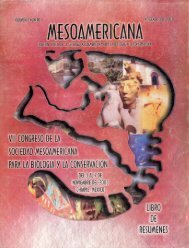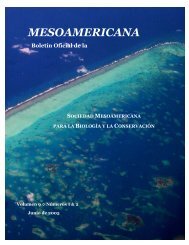MESOAMERICANA - Sociedad Mesoamericana para la BiologÃa y la ...
MESOAMERICANA - Sociedad Mesoamericana para la BiologÃa y la ...
MESOAMERICANA - Sociedad Mesoamericana para la BiologÃa y la ...
You also want an ePaper? Increase the reach of your titles
YUMPU automatically turns print PDFs into web optimized ePapers that Google loves.
<strong>Mesoamericana</strong> 13 (1) Agosto de 2009<br />
AVIFAUNA DE LOS CAYOS SANTA MARÍA, ENSENACHOS Y LAS BRUJAS, NORESTE<br />
DE VILLA CLARA, CUBA<br />
BIRDS OF THE KEYS SANTA MARÍA, ENSENACHOS, AND LAS BRUJAS, NORTHEAST<br />
VILLA CLARA, CUBA<br />
Edwin Ruiz Rojas*, Ángel Arias Barreto, Daysi Rodríguez Batista, Pedro B<strong>la</strong>nco Rodríguez, Patricia<br />
Rodríguez Casariego, Eneider E. Pérez Mena, Alejandro L<strong>la</strong>nes Sosa, Hiram González Alonso, Bárbara<br />
Sánchez Oria y A<strong>la</strong>in Parada Isada<br />
Centro de Estudios y Servicios Ambientales. Carretera Central Núm. 716 e/Colón y Cabo Brito. Santa C<strong>la</strong>ra. Vil<strong>la</strong> C<strong>la</strong>ra, Cuba<br />
*Autor de correspondencia: emonitoreo@vcl.cu<br />
Fecha de recepción: 6 de marzo de 2009 - Fecha de aceptado: 31 de julio de 2009<br />
RESUMEN. Entre marzo de 2001 y abril de 2007 se llevó a cabo un inventario de <strong>la</strong>s aves de los cayos Santa María,<br />
Ensenachos y Las Brujas, provincia Vil<strong>la</strong> C<strong>la</strong>ra, Cuba. Durante el estudio se emplearon tres métodos de muestreo:<br />
capturas con redes ornitológicas, conteo en parce<strong>la</strong>s circu<strong>la</strong>res y observaciones directas. Como resultado de ello, el cayo<br />
Las Brujas incrementó en 45 especies <strong>la</strong> composición de su avifauna, seguido por el cayo Ensenachos con 27 especies, y<br />
por último el cayo Santa María, que tuvo 20 nuevos registros con re<strong>la</strong>ción a <strong>la</strong>s listas publicadas con anterioridad por otros<br />
autores. El número total de especies de aves registradas en Santa María ascendió a 137, seguido de Las Brujas con 104 y<br />
Ensenachos con 65. Se constató <strong>la</strong> presencia de 82 especies de aves migratorias y 5 especies Casi Amenazadas (NT) de<br />
acuerdo con <strong>la</strong> lista proporcionada por <strong>la</strong> UICN en el año 2008, lo que le confiere a estos territorios ser de gran interés<br />
regional y nacional. Aunado a lo anterior, se discute el estado de algunas especies de aves residentes permanentes de Cuba,<br />
registradas con anterioridad en los cayos estudiados. Se enumeran <strong>la</strong>s áreas de mayor importancia y <strong>la</strong>s principales<br />
amenazas sobre <strong>la</strong> avifauna en estos cayos.<br />
Palbras c<strong>la</strong>ve: aves, inventario, cayería, Archipié<strong>la</strong>go Sabana-Camagüey.<br />
ABSTRACT. Between March 2001 and April 2007 a bird inventory was carried out in the Santa María, Ensenachos and<br />
Las Brujas Keys, Vil<strong>la</strong> C<strong>la</strong>ra province, Cuba. During the study, three sampling methods were used: captures with mist nets,<br />
circu<strong>la</strong>r plots counts and direct observations. As a result, the composition of avifauna in Las Brujas Key increased in 45<br />
species, followed by key Ensenachos Key with 27 species and <strong>la</strong>stly Santa María Key with 20 new registers in re<strong>la</strong>tion with<br />
previous lists published by other authors. The total number of bird species reported for Santa María ascended to 137,<br />
followed by Las Brujas with 104 and Ensenachos with 65. The presence of 82 species of migratory birds and 5 Near<br />
Threatened (NT) species according to IUCN (2008) was confirmed, conferring great regional and national interest to<br />
these territories. Furthermore, the status of some permanent resident bird species previously registered in the study area is<br />
discussed. The most important areas and the main threats to the avifauna in these keys are also mentioned.<br />
Keywords: birds, inventory, keys, Sabana-Camagüey Archipe<strong>la</strong>go.<br />
INTRODUCCIÓN<br />
El Archipié<strong>la</strong>go Sabana-Camagüey ha recibido<br />
históricamente más atención por parte de los ornitólogos<br />
en com<strong>para</strong>ción con el resto de los archipié<strong>la</strong>gos que<br />
rodean a <strong>la</strong> Is<strong>la</strong> de Cuba. Dentro de este, sin embargo, los<br />
cayos de mayor extensión territorial son los que cuentan<br />
con un considerable número de estudios referentes a <strong>la</strong><br />
avifauna (Garrido, 1973, 1976, 1978; Rega<strong>la</strong>do, 1981;<br />
Acosta y Berovides, 1984; Garrido et al., 1986; Kirkconnell<br />
44<br />
y Posada, 1988; ACC e ICGC, 1990a, 1990b; Kirkconnell y<br />
Garrido, 1991; González et al., 1992; Kirkconnell et al.,<br />
1993; Sánchez et al., 1994; Kirkconnell, 1998; Wal<strong>la</strong>ce,<br />
1998; Rodríguez, 2000).<br />
En 1989, cuando se identificaron los sitios del<br />
Archipié<strong>la</strong>go Sabana-Camagüey con interés <strong>para</strong> el<br />
desarrollo del turismo, se inició el inventario de <strong>la</strong> flora y <strong>la</strong><br />
fauna de los principales cayos, entre ellos los del noreste de<br />
Vil<strong>la</strong> C<strong>la</strong>ra. Los resultados obtenidos en esta zona y<br />
teniendo en cuenta <strong>la</strong> información precedente (Garrido,


